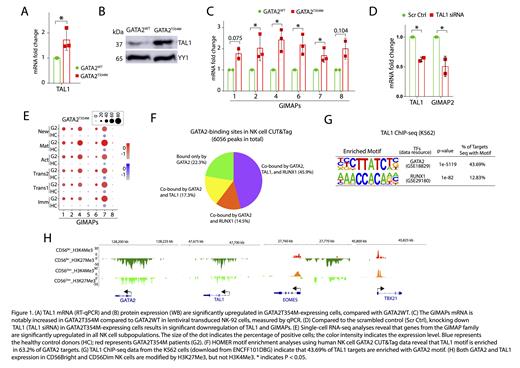Introduction: Natural killer (NK) cells, as the major subset of innate lymphocytes, produce proinflammatory cytokines and mediate anti-tumor cytotoxicity (1-3). Since NK cells are not limited by clonotypic receptors, they can be utilized in cell therapies against a broad spectrum of malignancies. Irrespective of the clinical potentials, the transcriptional regulation of the development and functions of human NK cells is far from fully understood. A dysregulated NK cell development is a hallmark of GATA2 haploinsufficiency (4)(eg. GATA2 T354M mutation). The specific loss of the CD56 bright NK cell population is a significant striking feature in GATA2-deficient patients (4), with or without reduced total CD56 dim NK cells (4, 12, 13). Consequently, the effector functions of these NK cells are significantly reduced, including inflammatory cytokine production and anti-tumor cytotoxicity (4, 12). However, a mechanistic understanding of GATA2 functions is lacking.
In humans, GATA2 forms a core heptad complex with six other transcription factors (TF), including TAL1, regulating more than 1000 target genes. However, the unique functions of the GATA2-TAL1 axis in immature and mature NK cell has not been established. Based on these, we hypothesize that GATA2-dependent and independent functions of TAL1 play an essential role in the development and functions of human NK cells.
Results: To explore the mechanism of co-transcriptional regulation of GATA2 and TAL1, we transduced NK-92 cells with lentiviral vectors containing GATA2 WT or GATA2 T354M plasmid and quantified TAL1 mRNA levels by qPCR and protein levels by WB. TAL1 is upregulated in GATA2 T354M-expressing NK-92 cells both at mRNA ( Fig. 1A) and protein levels ( Fig. 1B). TAL1 is a TF activating GTPase of immunity-associated protein (GIMAP) family super-enhancer regions in HSC and T cells (11). As TAL1 target genes, we further quantify GIMAP mRNA levels by qPCR. The result indicates that genes from the GIMAP family were notably upregulated in GATA2 T354M-expressing NK-92 cells ( Fig. 1C). Knocking down TAL1 results in the significant downregulation of TAL1 and GIMAPs in GATA2 T354M-expressingcells ( Fig. 1D). To further validate the GATA2-TAL1 axis, sorted NK cells from PBMCs of three GATA2 T354M patients and five age-matched healthy controls (HC) were analyzed with single-cell RNA-seq. We identified the genes from GIMAP family were significantly upregulated in all three GATA2 T354M patients. The representative data from one patient is shown in Fig. 1E. To explore how GATA2 and TAL1 mediate transcriptional regulation, we performed GATA2 CUT&Tag experiments with human NK cells, in which TAL1 motif was predominately enriched in 63.2% of GATA2 targets among NK cells through HOMER motif enrichment analyses ( Fig. 1F). On the other hand, the TAL1 ChIP-seq data from the K562 cells (download from ENCFF101DBG) reveals that the GATA2 motif is enriched in approximately 44% of TAL1 targets ( Fig. 1G). Moreover, both GATA2 and TAL1 expression in NK cells are modified by H3K27Me3 instead of H3K4Me3, suggesting a repressive methylenation signature in their expression ( Fig. 1H).
Conclusion: Based on this study, we uncover a novel role for the GATA2-TAL1 axis in human NK cells. we define the transcriptional regulation role of GATA2 and TAL1 complex and provide direct evidence for the mechanism of NK cell deficiency among GATA2 T354M patients. Importantly, through our current study, we will determine the unique role of TAL1 in NK development and function and its transcriptional network.
Disclosures
No relevant conflicts of interest to declare.


